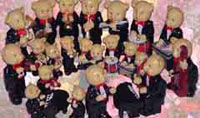Woodpeckers, キツツキ
Above is just a small part of our gift-packed souvenir stamp-collection;
inquire by email if the picture or subject of your interest is not here: we will be obliged to accomodate your wishes.
ここに掲載の写真は一部のみです。ご希望のジャンル、絵柄などございましたら
お問い合わせください。
Woodpeckers are near passerine birds of the order Piciformes. They are found worldwide and include numerous species, usually numbered at 218 (including the Ivory-billed).
Some woodpeckers and wrynecks in the order Piciformes have zygodactyl feet, with two toes pointing forward, and two backward. These feet, though adapted for clinging to a vertical surface, can be used for grasping or perching. Several species have only three toes. The long tongue found in some woodpeckers can be darted forward to capture insects.
Woodpeckers gained their English name because of the habit of some species of tapping and pecking noisily on tree trunks with their beaks. This is both a means of communication to signal possession of territory to their rivals, and a method of locating and accessing insect larvae found under the bark or in long winding tunnels in the tree.
The woodpecker first locates a tunnel by tapping on the trunk. Once a tunnel is found, the woodpecker chisels out wood till it makes an opening into the tunnel. Then it worms its tongue into the tunnel to try to locate the grub. The tongue of the woodpecker is long and ends in a barb. With its tongue the woodpecker skewers the grub and draws it out of the trunk.
Woodpeckers also use their beaks to create larger holes for their nests which are 15-45 cm (6-18 inches) below the opening. These nests are lined only with wood chips and hold 2-8 white eggs laid by the females. Because the nests are out of sight, they are not visible to predators and eggs do not need to be camouflaged. Cavities created by woodpeckers are also reused as nests by other birds, such as some ducks and owls, and mammals, such as tree squirrels.
The above explanation comes from

出典: フリー百科事典"ウィキペディア"

